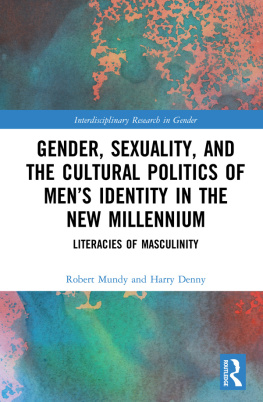Producing Masculinity
Thoughtful, witty, and illuminating, in this book Michele White explores the ways normative masculinity is associated with computers and the Internet and is a commonly enacted online gender practice. Through close readings and a series of case studies that range from wedding forums to mens makeup video tutorials, White considers the ways masculinities are structured through peoples collaborations and contestations over the establishment of empowered positions, including debates about such key terms and positions as the nice guy, nerd, bro, and groom. She asserts that cultural notions of masculinity are reliant on figurations of women and femininity, and explores cultural conceptions of masculinity and the association of normative white heterosexual masculinity with men and women. A counterpart to her earlier book, Producing Women, White has crafted an excellent primer for scholars of gender, media, and Internet studies.
Michele White is a Professor in the Department of Communication at Tulane University. Her field is media and visual culture studies, with a focus on the forms of cultural production that are associated with the Internet and computer. She is the author of Producing Women: The Internet, Traditional Femininity, Queerness, and Creativity (2015), Buy It Now: Lessons from eBay (2012), and The Body and the Screen: Theories of Internet Spectatorship (2006).
First published 2019
by Routledge
52 Vanderbilt Avenue, New York, NY 10017
and by Routledge
2 Park Square, Milton Park, Abingdon, Oxon, OX14 4RN
Routledge is an imprint of the Taylor & Francis Group, an informa business
2019 Taylor & Francis
The right of Michele White to be identified as author of this work has been asserted by her in accordance with sections 77 and 78 of the Copyright, Designs and Patents Act 1988.
All rights reserved. No part of this book may be reprinted or reproduced or utilised in any form or by any electronic, mechanical, or other means, now known or hereafter invented, including photocopying and recording, or in any information storage or retrieval system, without permission in writing from the publishers.
Trademark notice: Product or corporate names may be trademarks or registered trademarks, and are used only for identification and explanation without intent to infringe.
Library of Congress Cataloging-in-Publication Data
A catalog record for this title has been requested
ISBN: 978-0-367-15079-2 (hbk)
ISBN: 978-0-367-15082-2 (pbk)
ISBN: 978-0-429-05491-4 (ebk)
This is dedicated to the many folks who work at the edges of structures. It is also in memory of Frank Ukadike and his kind humor and celebratory dances.
This book goes into print as online sites insistently produce and extend conceptions of masculinity. Internet sites ordinarily correlate white heterosexual men with normative masculinity and suggest that the link between these positions is natural. While computer technologies and Internet sites often emphasize the unmediated and natural, including the shrinking of bevels and the thickness of screens, the windows convention, and indications that devices facilitate the material world, normative mens masculinity is clearly produced through the kinds of online practice that I consider later in this book. The correlation of the Internet with gendered participants is also asserted through site design, language choices, differentiating programmers from contributors, depictions and features of avatars, and varied narratives and memes.
The Rules of the Internet were supposed to act as a kind of guide for individuals who identified with the group Anonymous and included a number of indications about gender. There is a notation that There are no girls on the Internet and that individuals who claim to be women should provide images of their Tits or GTFO (get the fuck out).ethics because it suggests that cock inherently goes with online culture and is welcome to enter without active consent.
Men and masculinity continue to be correlated with the computer and Internet because technologies and technological skill are coded as male and because of such schemas as the rules. The GamerGate harassment of women who are involved in producing and commenting on computer games, threats to feminist journalists, and Donald Trump and some other mens dismissive online comments about women have made it difficult for women to engage online without being threatened and encountering painful and misogynistic content. We are at a moment when Trump can use Twitter and what the New York Times calls his presidential bully pulpit to call Omarosa Manigault Newman a crazed, crying lowlife and that dog. Through such actions, men make themselves into judges and powerful subjects by distinguishing themselves from women. Such narratives about mens rights, which I consider in more detail later in this book, are supposed to be in reaction to the cruel and dismissive treatment of women.
The current political climate and restrictive constructions of gender and other worldviews make the support of colleagues and friends all the more appreciated. My ongoing critical and intellectual endeavors have been supported by the generosity of the Carol Lavin Bernick Faculty Grant, Carol S. Levin Fund for Faculty Research and Creative Projects, Newcomb College Institute, Tulanes Committee on Research Fellowship, and Tulane University. I owe a debt of gratitude to the people who administered these funds, including Michael Cunningham, Robin Forman, Carole Haber, Tara Hamburg, Sally Kenney, Kathleen Moises, Laura Wolford, and members of the grant review committees. The Feminist and Queer Theory Reading Group and the intellectual contributions of Jean Dangler, Felicia McCarren, Supriya Nair, Mimi Schippers, and Allison Truitt have been essential to my ongoing thinking and intellectual development. Equally important have been dialogues with Beth Freeman, Katariina Kyrl, Kathryn Bond Stockton, and Bernadette Wegenstein who discussed feminist and queer theory with reading group participants. I have also savored conference considerations of masculinity, including reflections on beauty culture, with Anna Everett, Sasha Goldberg, Jessalynn Keller, Dara Persis Murray, Susanna Paasonen, and Brenda Weber.
My conceptualization of the Internet continues to be informed by the NEH-funded summer seminar on literature and information technologies, which Kate Hayles skillfully led at the University of California-Los Angeles. Other seminar participants, including Kathleen Fitzpatrick and Tara McPherson, contributed to my intellectual inquiries. My departmental colleagues have supported my work with departmental resources and their research knowledge. This includes research dialogues with Eric Herhuth and Krystal Cleary. Michele Adams has been a careful listener and Mike Syrimis has provided key references and unwavering encouragement. Mark Anderson has kindly located texts related to my interests and advanced my understanding of computer and Internet technologies. Hollis Griffin and the anonymous reviewers provided careful readings of this project. I owe a great deal to Erica Wetter at Routledge for her early and continual enthusiasm for this book and related projects. Ultimately, it is a great pleasure to discuss these and related issues with my family and to experience their ongoing feminist support. This book would never have been completed without the nurturance of Anderson, Pauline Farbman, and Stephanie White.
Notes






